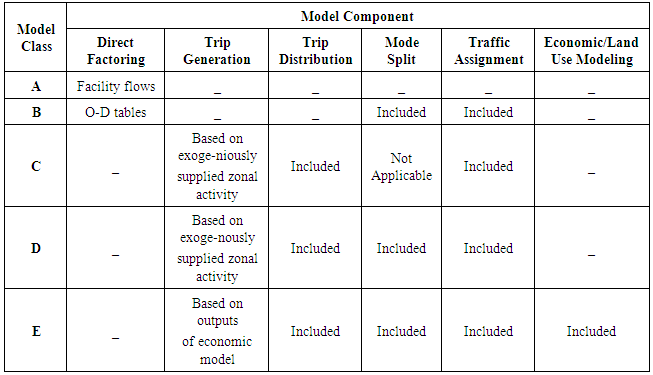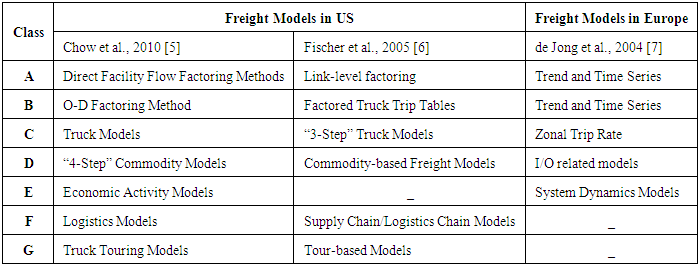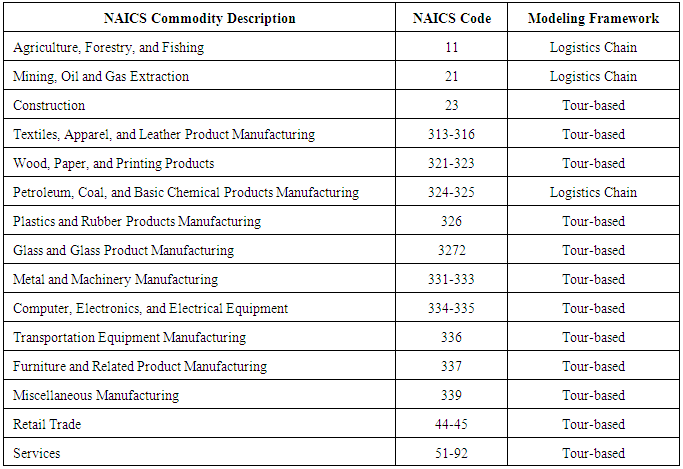-
Paper Information
- Paper Submission
-
Journal Information
- About This Journal
- Editorial Board
- Current Issue
- Archive
- Author Guidelines
- Contact Us
International Journal of Traffic and Transportation Engineering
p-ISSN: 2325-0062 e-ISSN: 2325-0070
2016; 5(1): 19-26
doi:10.5923/j.ijtte.20160501.03

Comparison of Freight Demand Forecasting Models
Ehsan Doustmohammadi1, Virginia P. Sisiopiku1, Michael D. Anderson2, Mehrnaz Doustmohammadi2, Andrew Sullivan1
1Department of Civil Engineering, University of Alabama at Birmingham, USA
2Department of Civil Engineering, University of Alabama in Huntsville, USA
Correspondence to: Ehsan Doustmohammadi, Department of Civil Engineering, University of Alabama at Birmingham, USA.
| Email: |  |
Copyright © 2016 Scientific & Academic Publishing. All Rights Reserved.
This work is licensed under the Creative Commons Attribution International License (CC BY).
http://creativecommons.org/licenses/by/4.0/

In recent years, many governmental agencies and private companies came to a growing realization of the need for accurate forecasting freight volumes as part of the travel demand forecasting process. Freight demand forecasting is a complex process and has not been explored in the same degree as travel demand forecasting for passenger vehicles. The purpose of this paper is to provide a review and synthesis of available freight demand forecasting models to assist stakeholders in their efforts to incorporate such models into the transportation planning process. The paper examines and contrasts traditional freight demand forecasting models and as well as more recently proposed tour-based models, and discusses model features, advantages, limitations, and suitability for application.
Keywords: Freight Transportation, Traditional Freight Models, Tour-based Models
Cite this paper: Ehsan Doustmohammadi, Virginia P. Sisiopiku, Michael D. Anderson, Mehrnaz Doustmohammadi, Andrew Sullivan, Comparison of Freight Demand Forecasting Models, International Journal of Traffic and Transportation Engineering, Vol. 5 No. 1, 2016, pp. 19-26. doi: 10.5923/j.ijtte.20160501.03.
Article Outline
1. Introduction
- In the US, 117.5 million households, 7.4 million business establishments, and 89,500 governmental units are part of an enormous economy that demands the efficient movement of freight [1]. The freight transportation system comprises five basic transportation modes, namely, highway, rail, water, air and pipelines. Goods are shipped either by a single mode or a combination of modes. According to the 2012 Commodity Flow Survey (CFS), produced by the US Bureau of the Census, over 11 billion tons of commodities valued at greater than $13 trillion are shipped annually over the nation’s freight transportation system in the United States [1]. In 2012, based on value and tonnage, trucking was the dominant mode used to transport freight in the United States, handling roughly 70% of the nation’s freight movements [1]. With the heavy reliance on trucks for freight transportation, the need to consider their impacts on the roadway system performance becomes of paramount importance. This, in turn, creates a need to consider freight transportation as part of the transportation planning process to ensure that the roadway network does not impose any limitations in freight mobility and vice versa. To assist in the transportation planning process, efficient and reliable freight demand forecasting models are required to predict short- and long-term freight demand, freight’s impact on transportation network operations and the interaction between truck and passenger vehicle travel. This research paper reviews freight transportation forecasting modeling approaches focusing on input needs and requirements, key assumptions and processes, expected outputs, and suitability for application. The modeling approaches include traditional freight forecasting models and recently proposed tour-based models. This paper provides researchers and practitioners with knowledge to better understand capabilities and limitations of freight forecasting modeling options and assists them in their efforts toward selecting the best model for adoption.
2. Freight Forecasting Modeling Issues and Challenges
- As freight demand continues to grow, transportation planners and operators face greater pressure to develop improved approaches for tracking and analyzing commodity flows [4]. Several research studies confirm that the development of freight forecasting methods still lags behind the development of passenger transportation forecasting, as far as both theoretical and simulation modeling analyses are concerned [2, 3, 6, 8, 9, 12, 16, 19, 23, 24, 26, 29]. One difficulty in forecasting freight demand relates to the numerous parties involved in the shipping process and the large variety of commodities that are moved by the available transportation modes. The lack of a standardized freight modeling framework and the inherent limitations of freight disaggregated data availability have hindered the development and use of freight forecasting models [2]. In addition, the existence of a wide array of metrics used to quantify freight traffic such as freight trips, tonnage, volume, mode, value schedule and tours adds to the complexity of accurately capturing the impact of policy decisions on travel times, reliability and costs [3].
3. Freight Demand Modeling Approaches
3.1. Traditional Freight Demand Forecasting Models
- In 2008, the National Cooperative Highway Research Program (NCHRP) published a comprehensive review of traditional freight demand forecasting models used in practice in the US [4]. According to the NCHRP report, five approaches are most commonly employed in freight demand forecasting and are classified from A to E as follows [4]: Class A: Direct facility flow factoring method, Class B: O-D factoring methodClass C: Truck modelClass D: Four-step commodity model, and Class E: Economic activity model. More specifically, Class A (Direct facility flow factoring method) involves estimating a growth factor from current and past truck count data and applying the growth factor to observed truck traffic volumes. This method is mostly used for the short-term forecast of freight truck flows to determine link-by-link volumes [4, 5].Class B (O-D factoring method) is similar to Class A except that the growth factors are being applied to the base year Origin–Destination (O–D) trip table [6]. In Class C (Truck model) aggregate truck trips are generated separately for internal trips between zones (I-I) and external trips between internal and external zones (E-I, I-E, and E-E). The truck types often considered in truck models are broadly classified into light, medium, and heavy trucks based on gross vehicle weight ratings. The Class C model uses the traditional trip distribution and traffic assignment method to assign the truck trips to the network links [4]. Truck models cannot analyze shifts between modes since, by definition, they comprise only the truck freight mode. They are usually part of a comprehensive model which estimates both passenger and goods transportation and consequently use a simultaneous assignment of truck trips with vehicle trips. Class D (Four-step commodity model) is a commodity-based version of the Class C vehicle-based model. The model develops forecasts of commodity flow and converts the commodity truck flow into daily freight truck trips as part of the modeling process [2]. This method has been used as a statewide freight model framework by several states such as Texas, Wisconsin, Florida, Iowa, and Pennsylvania [4, 5]. The principal shortcoming of this approach is the limited detail regarding local pickup and delivery trips and service trips which are generally not captured in the commodity flow data sets or service trips [6]. Therefore, truck tours or trip chains are overlooked in the traditional four-step commodity modeling approach [7].Class E (Economic activity model) is a model with two key elements that work together: i.e., an economic/land use model and a freight transportation demand model [5]. Hence, it is crucial to grasp the interrelationships between the land use, economic factors, and freight transportation in order to develop robust models to accurately perform freight flows estimation using economic activity models [1]. Table 1 summarizes the five basic model classes (A through E) and six modeling components. The model classes share many basic components [4]. It should be noted that the literature review suggests that no model in classes A to E alone is capable of addressing all freight policy and analytical needs [4, 5]. Also, the models pay little attention to truck types, trip patterns, trip lengths, or comparisons with truck counts (which are very difficult to obtain).
|
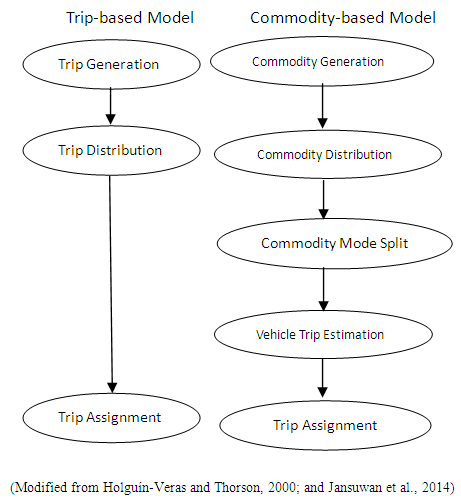 | Figure 1. Trip-based and Commodity-based Models |
3.2. Advanced Freight Demand Forecasting Models
- The two primary types of freight models commonly used in practice (i.e., vehicle-based or commodity-based) suffer from major limitations. Vehicle-based models fail to model the underlying economic behaviors from which the demand is actually derived; while commodity-based models fail to realistically account for vehicle activities, especially in urban settings, for which evaluation and impact assessment are most crucial [2, 5].To address some of these limitations, in the recent years, advanced freight demand forecasting models have been proposed, trending towards more disaggregate models that incorporate supply chain procedures or truck touring aspects. As Fischer et al. concluded, two additional classifications should be considered, namely Logistics Chain Models (Class F) and Vehicle Touring Models (Class G). These new classifications result from the need to improve on the sensitivity of models in the economics of commodities for policy making (Class F) and more realistically capture the movements of vehicles (trucks) for impact assessments (Class G) [6]. Table 2 summarizes all models considered with respect to classifications discussed in various studies [3, 5, 6, 7].
|
|
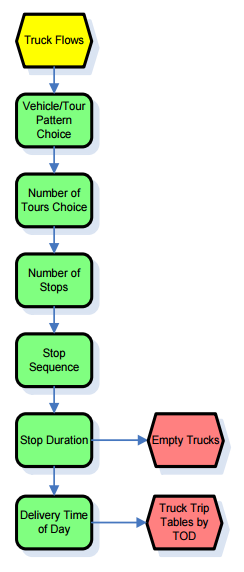 | Figure 2. Freight Forecasting Framework in Chicago (Adopted from Outwater et al., 2012) |
4. Discussion
- This paper summarized a variety of freight modeling techniques based on available literature sources. Seven classes of models were introduced (Class A through G), ranging from traditional direct modeling approaches to recently developed tour-based models. Earlier sections provided a summary of main features of such models along with related references whereas Table 4 illustrates the associated inputs and outputs.
|
 | Figure 3. Freight Forecasting Models Metrics |
|
|
5. Conclusions
- Understanding the opportunities and challenges associated with freight demand modeling is an issue of great importance in transportation planning. The selection of a suitable model for forecasting freight traffic demand is also of major interest. The paper provides a systematic review and synthesis of the state-of-the-practice in freight demand forecasting models in order to guide the selection and adoption of such models into the transportation planning process.The review of freight modeling techniques reveals that there is no single model which is able to meet all of the objectives. By incorporating features from several of the existing modeling frameworks it would be possible to design a freight modeling framework suitable for addressing public and private sectors’ needs. Although the tour-based models hold the greatest promise among the models explored in this study for future refinement and implementation, the model developments requires more detailed input data as well as more budget. Research efforts are currently being devoted to the development of such models and the data bases needed to develop and support them. However, the state of the art in true goods movement modelling is not yet sufficiently developed to the point where it is easily adoptable by most urban travel forecasters.
 Abstract
Abstract Reference
Reference Full-Text PDF
Full-Text PDF Full-text HTML
Full-text HTML